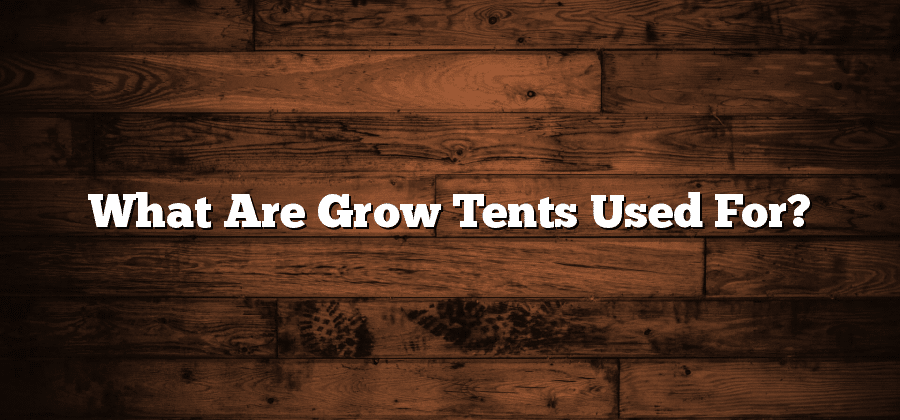Understanding the Purpose of Grow Tents
Grow tents are a vital component for indoor gardening enthusiasts. They serve the purpose of creating a controlled environment for plants to thrive in. By mimicking the outdoor growing conditions, these enclosures allow growers to efficiently cultivate plants all year round, regardless of external weather conditions.
One of the primary reasons for using grow tents is to regulate the light and temperature levels. These tents are typically made of reflective and insulating materials that help distribute light evenly across the plants. The interior walls of the tent are often coated with reflective material, bouncing back the light to reach lower leaves and ensuring even growth. Temperature control is also crucial, as it directly affects the plants’ health and productivity. Grow tents come with ventilation systems that help maintain an optimal temperature, preventing overheating or excessive cooling. Together, these features create an ideal environment where plants can photosynthesize and grow at an accelerated pace.
Creating an Optimal Growing Environment
Creating an optimal growing environment is crucial for the success of indoor gardening. A well-designed environment can ensure that plants receive the necessary nutrients, light, and temperature for healthy growth. One key aspect of creating an optimal growing environment is providing adequate and balanced lighting. Plants need the right amount of light to carry out photosynthesis, which is essential for their growth and development. By installing high-quality grow lights, indoor gardeners can mimic natural sunlight and provide plants with the ideal light spectrum for each stage of growth.
Temperature control is another important factor in an optimal growing environment. Different plants have specific temperature requirements, and maintaining the right temperature range can significantly impact their overall health. Too high or too low temperatures can stress plants and hinder their growth. Investing in a reliable temperature control system, such as a thermostat, can help maintain a consistent and favorable environment for plants. It is also crucial to consider factors like airflow and humidity levels, as they can affect temperature regulation and play a role in preventing pests and diseases.
Overall, creating an optimal growing environment involves carefully considering lighting, temperature, airflow, and humidity levels. By paying attention to these factors, indoor gardeners can provide their plants with the ideal conditions for healthy and thriving growth.
Controlling Light and Temperature Levels
To create the ideal growing environment in a grow tent, controlling light and temperature levels is paramount. Providing the right amount and quality of light is crucial for the photosynthesis process and ensuring healthy plant growth. Most grow tents come equipped with reflective materials on the interior walls to maximize light distribution and minimize energy wastage. This reflective surface helps to bounce light around the plants, ensuring that all areas receive an adequate amount of light for robust growth. Additionally, using LED grow lights can offer a more precise spectrum of light tailored to the specific needs of plants, promoting optimal photosynthesis and ultimately increasing yield.
Alongside controlling light, maintaining the appropriate temperature in a grow tent is essential for plant health and growth. Different plant species have specific temperature requirements, so it is important to monitor and regulate the temperature accordingly. High temperatures can cause stress and damage plants, while low temperatures can slow down growth or even result in plants’ death. Many modern grow tents are designed with built-in ventilation systems, including fans and vents, to help keep temperatures within the desired range. It is advisable to invest in a quality thermometer and a thermostat to monitor temperature levels consistently and make any necessary adjustments promptly.
By effectively controlling light and temperature levels, growers can create an optimal environment that meets the unique needs of their plants. This level of control allows for precise adjustments, ensuring healthy and robust growth while maximizing overall yield in indoor gardening.
Maximizing Space Efficiency for Indoor Gardening
When it comes to indoor gardening, space is often a limiting factor. Maximizing space efficiency is crucial to make the most of your indoor gardening setup. One effective way to do this is by utilizing vertical space. Instead of focusing solely on horizontal garden spaces, consider incorporating vertical gardening techniques. This can be done by using hanging planters, stacking shelves, or even installing a vertical garden wall. By optimizing vertical space, you can significantly increase the number of plants you can grow in a limited area, maximizing your indoor gardening potential.
Another space-saving technique for indoor gardening is utilizing compact and multi-functional planters. Instead of using bulky individual pots for each plant, opt for planter boxes or trays where multiple plants can be grown together. Modular systems and tiered plant stands are also great options as they allow you to stack plants vertically, saving valuable floor or shelf space. Additionally, consider using hanging baskets or wall-mounted planters to keep plants off the ground and free up even more space. By employing compact and multi-functional planters, you not only maximize space efficiency but also create an organized and visually appealing indoor garden.






